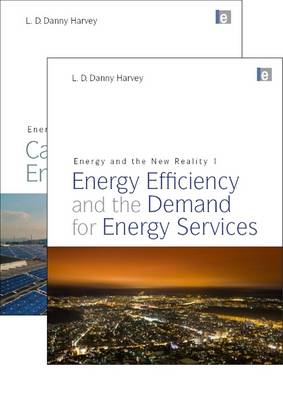Volume 1:
Reducing and managing humanity's demand for energy is a fundamental part of the effort to mitigate climate change. In this, the most comprehensive textbook ever written on the subject, L.D. Danny Harvey lays out the theory and practice of how things must change if we are to meet our energy needs sustainably. The book begins with a succinct summary of the scientific basis for concern over global warming, then outlines energy basics and current patterns and trends in energy use. This is followed by a discussion of current and advanced technologies for the generation of electricity from fossil fuels. The book then considers in detail how energy is used, and how this use can be dramatically reduced, in the following end-use sectors:- buildings
- transportation
- industry
- food and agriculture
- municipal servicesThe findings from these sector-by-sector assessments are then applied to generate scenarios of how global energy demand could evolve over the coming decades with full implementation of the identified and economically-feasible energy-saving potential. The books ends with a brief discussion of policies that can be used to reduce energy demand, but also addresses the limits of technologically-based improvements in efficiency in moderating demand and of the need to re-think some of our underlying assumptions concerning what we really need. Along with its companion volume on C-free energy supply, and accompanied by extensive supplementary online material, this is an essential resource for students and practitioners in engineering, architecture, environment and energy related fields.
Online material includes: Excel-based computational exercises, teaching slides for each chapter, links to free software tools.Volume 2:
Transforming our energy supplies to be more sustainable is seen by many to be the biggest challenge of our times. In this comprehensive textbook, L.D. Danny Harvey sets out in unprecedented detail the path we must take to minimize the effects that the way we harness energy will have on future climate change. The book opens by highlighting the importance of moving to low carbon technologies for generation, then moves on to explain the functioning, potential and social/environmental issues around:- solar energy
- wind energy
- biomass energy
- geothermal energy
- hydroelectric power
- ocean energy
- nuclear energyIt also covers the options for carbon capture and storage and the contexts in which low carbon energy can best be utilized (potential for community integrated systems, and the hydrogen economy). The book closes with scenarios that combine the findings from its companion volume (concerning the potential for limiting future energy demand) with the findings from this volume (concerning the cost and potential of C-free energy systems) to generate scenarios that succeed in limiting future atmospheric CO2 concentration to no more than 450 ppmv. Detailed yet accessible, meticulously researched and reviewed, this work constitutes an indispensible textbook and reference for students and practitioners in sustainable energy and engineering.
Online material includes: Excel-based computational exercises, teaching slides for each chapter, links to free software tools.
- ISBN10 1849710740
- ISBN13 9781849710749
- Publish Date 20 May 2010
- Publish Status Active
- Out of Print 19 December 2011
- Publish Country GB
- Publisher Taylor & Francis Ltd
- Imprint Earthscan Ltd
- Format Hardcover
- Pages 1200
- Language English
